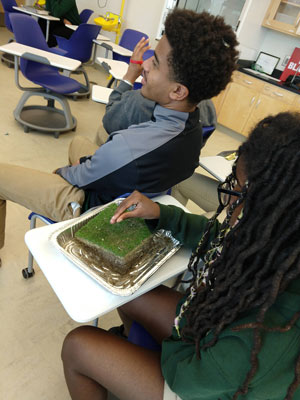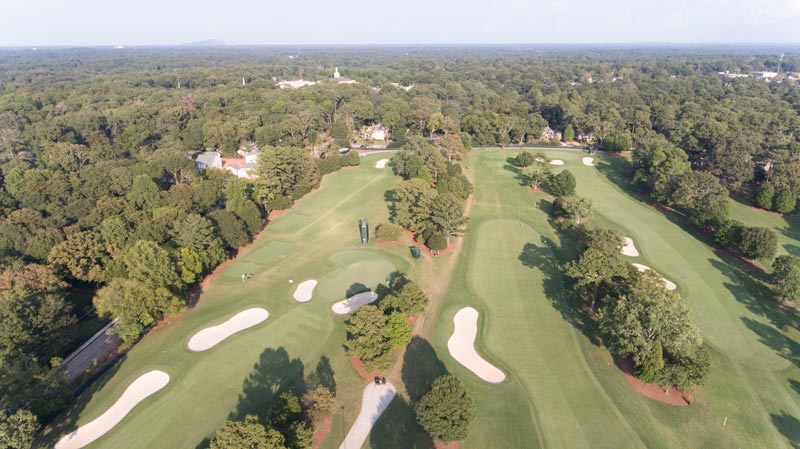
East Lake Golf Club agronomist Brant Mackey leads a classroom presentation at Drew Charter School in Atlanta, tying some of the everyday aspects of golf course maintenance to the high school students’ science and math curriculum. Photos courtesy of East Lake Golf Club
Q: “What does grass need in order to grow?”
A: “Love.”
That was one of the replies from a group of high school sophomores at Drew Charter School in southeast Atlanta when staff from East Lake Golf Club stopped by their classroom on March 15. Other student responses covered the basics of air, water, sunlight and favorable temperatures.
At Drew Charter School, the map for a successful academic experience is based on STEAM — science, technology, engineering, arts and math. The school employs project-based learning, which gives students the opportunity to encounter and solve real-world problems in the STEAM environment.
“We want the students to understand there is a direct connection between what they are learning in the classroom and how they will use that knowledge in the real world,” says Courtney Bryant, STEAM project coordinator for Drew Charter School. “Occasionally, we open our school doors to guest presenters for STEAM Workshop Day.”
By nature, golf courses are excellent laboratories for science and math. And although East Lake Golf Club (ELGC) is located just a block from Drew Charter School, there wasn’t enough time to bring multiple classes to the golf course, so ELGC brought the golf course to the students. The club’s agronomy department facilitated five 45-minute workshops for five different sophomore classes, each session touching on teamwork, science and math.
Students first participated in teamwork exercises, lining themselves up by birthdate or by height without using verbal communication. When they were finished, they were asked to identify the purpose of such exercises. The students then watched a short video of the ELGC maintenance staff working together to prepare for the 2018 Tour Championship, which was followed by a discussion of the importance of teamwork in achieving success on a golf course.
“We wanted to include the teamwork element in our presentation because it is so essential both in working on the golf course and life in general,” says Brant Mackey, agronomist at East Lake Golf Club. “The students responded well to the exercises and the discussion.”

Right: A Drew Charter School student takes an up-close, hands-on look at a turf sample from the East Lake Golf Club nursery.
Next, students split into small groups and were given turfgrass samples from ELGC’s nursery green to examine and touch. The groups were asked to share their observations, and the ELGC team used the comments to open a dialogue about plant growth, photosynthesis, chlorophyll, soil properties and other related topics. Students engaged by sharing what they’d learned in their science classes and how those lessons directly applied to what they noticed when inspecting the turf samples.
To cap the workshop, students were given a diagram of the 18th green at ELGC and tasked with determining its area by square footage. Using skills they’d learned in the classroom, students led themselves (with assistance when needed) through the process of multiplying length by width to obtain the area of an irregular shape, such as a golf green. After they’d worked out the area, students were provided with measuring beakers and water to “guesstimate” the amount of Primo (trinexapac-ethyl) to apply to the green. Then, groups were given the rate (1 ounce/acre) and asked whether they would like to alter their initial projections, which required converting acres to square feet.
“In a relatively short period of time, we were able to incorporate several aspects of science (biology and chemistry) and math (geometry and algebra) in the presentation,” says Mackey. “Our goal was to show the students how what they are learning in the classroom specifically applies to turfgrass management on a daily basis.”

The 18-hole East Lake Golf Club was purchased by a local charitable foundation in 1993, and its renovation was a catalyst for revitalizing the surrounding East Lake community. Proceeds from operations — more than $20 million to date — are returned to the community via the East Lake Foundation. The club has been the home of the Tour Championship since 2005. This aerial shot is of holes 1 through 4.
In the past quarter-century, Atlanta’s East Lake neighborhood has been transformed from one of the nation’s worst public housing projects into a thriving community, and East Lake Golf Club itself has been part of that revival. The ELGC mission — “Golf with a purpose” — aligns with the values of the entities within the greater East Lake community, whose overall goal is to foster a mixed-income community that offers quality education and affordable housing. Revenues from East Lake Golf Club are directed back into the East Lake community to support continued revitalization and success.
“Drew Charter School’s STEAM Workshop Day including East Lake Golf Club is a wonderful example of two organizations within our community working together to achieve our mission,” says Cynthia Kuhlman, Ph.D., director of educational achievement for the Cousins Foundation and board chair for Drew Charter School.
Eric Stratton is a freelance writer based in Atlanta.